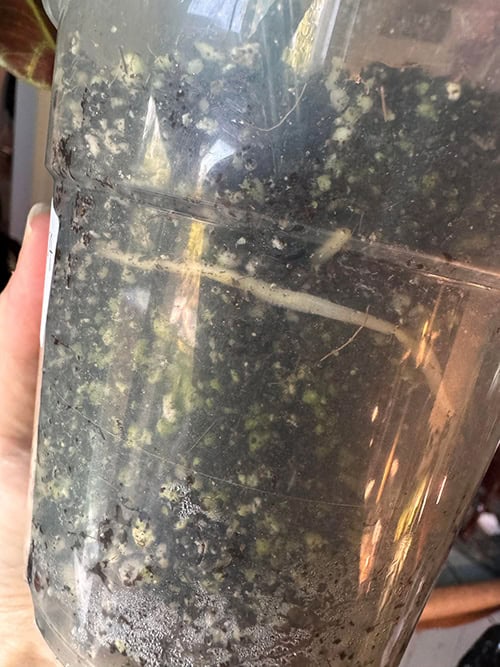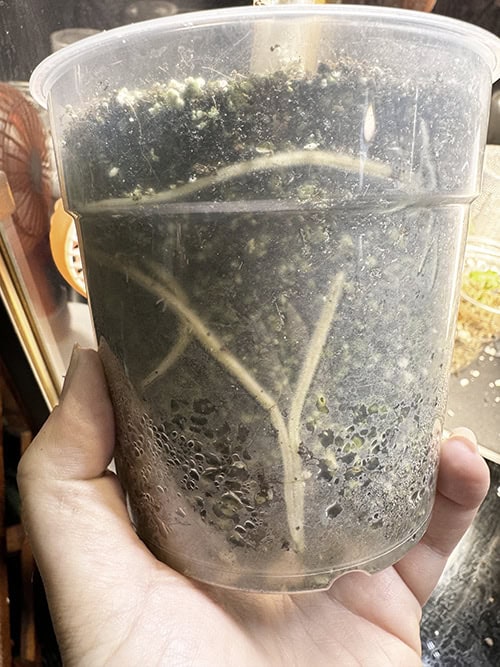Alocasia Stress After Transportation
"Why is my new Alocasia dropping its leaves?"
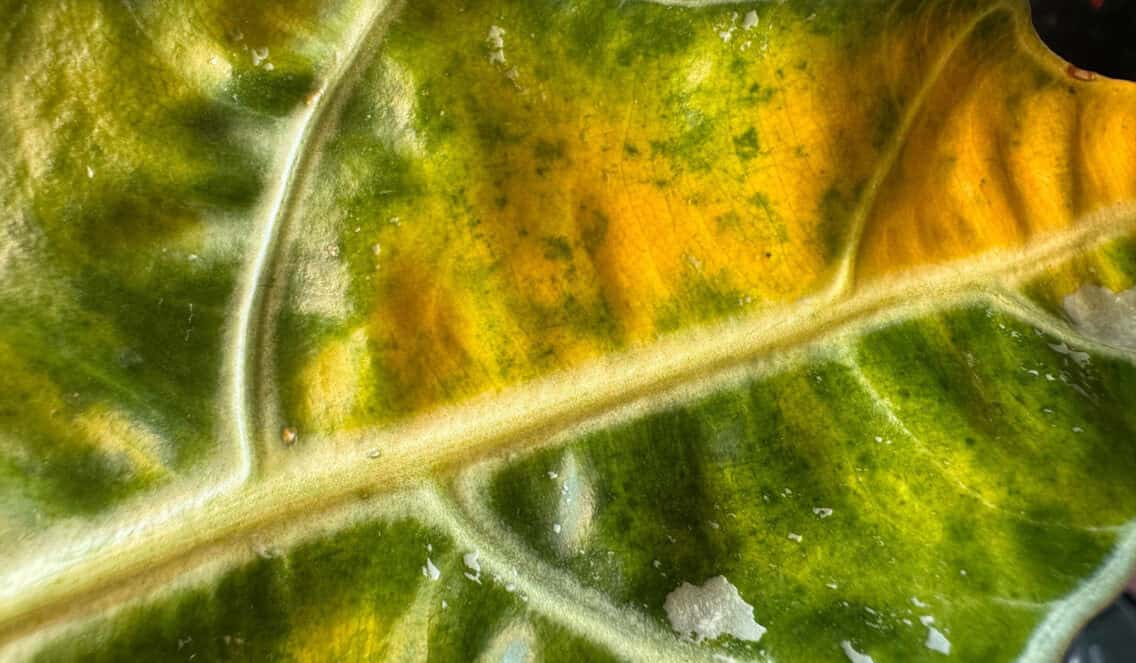
Alocasias are stunning and inspiring houseplants, but they can be sensitive to the stress caused by transportation. During transit, plants are exposed to various factors such as temperature fluctuations, darkness, vibrations, and lack of humidity, which can cause stress. This stress often manifests in the plant's appearance and growth. In this post, I will go over the signs of stress and how to alleviate it.
Share
Alocasias, sometimes referred to as as elephant ears (although nowadays it would rather refer to Colocasias), are often perceived as drama llamas. If you have experience with them, you already know that these plants have a tendency to react dramatically to even the smallest changes. In other words, these plants like to keep things safe and familiar, and change stresses them out to the point where the plant decides that it’s better to save energy and minimize any energy consumtion = Get rid of some leaves.
Even a switch to a larger pot or better growing medium can be enough to make the plant go limp and throw some yellowing on a leaf. You can imagine that when an Alocasia goes on a trip and moves to a completely new home, with different air quality, humidity, daily rhythm and lighting, it might not take the transition that well. When an Alocasia is stressed, it also becomes more susceptible to all kinds of problems.
Sometimes I see people on Facebook groups blaming the seller and think that there’s something wrong with the plant. But an Alocasia does what Alocasias do, and when the plant stresses, what else can we expect except a… well. Stress reaction.
How To Recognice Stress in Alocasias
*Note! Many symptoms can also be related to other plant issues. Therefore, symptoms should be examined collectively. For example, if you have a yellow leaf, check if there are any pests on the plant. Then check for any diseases in the roots. Next, look for signs of possible fungal infections. Overwatering, underwatering, too much fertilizer etc can also be the reason. Once more serious factors have been ruled out, you can be fairly certain that the issue is indeed just stress.
Here are some signs of stress in Alocasias:
1. Yellowing and Dropping Leaves
A typical reaction to transport can be that one or more leaves turn yellow and drop off. This is the plant’s way of reducing water consumption and adapting to new conditions. Especially if the dropped leaf is an older one, this reaction is quite expected. It can, of course, be quite a shock if you’ve spent hundreds of euros on a two-leaf plant. However, all you can do is wait. When a leaf starts to yellow rapidly, there’s nothing you can do. Let the chlorophyll retract into the plant, then when there’s nothing left, cut off the bad leaf. The plant will produce a new leaf in time. And even if it would kill all of its leaves, that’s the plant’s solution to the situation where it interprets that times are now rough, and it’s better to withdraw for a moment and grow back when the environment seems more suitable.
2. Drying Leaves
Brown or dried areas may appear on the edges of the leaves, often due to a lack of humidity or sudden temperature changes. Unfortunately, these browned edges cannot be fixed and will remain a temporary cosmetic flaw on the plant.
3. Curled Leaf Edges
Curling or rolling edges of the leaves are also typical signs of stress. During transport, there is a lot of fluctuation in temperature as well as humidity levels. The leaf is calibrating itself to the new environment and can sometimes express stress and thirst. Something important to think of is how the plant is transferred. For example, if it’s removed from the soil, some of the finest roots will likely get damaged. These finest roots are actually the part of the root system that is responsible of actually absorbing the water. If those fine roots suffer a lot, the plant will struggle drinking and may show signs of thirst. The root system renews itself and grows constantly, so you need to give the plant some peace and time to fix its roots.
4. General Wilting
The plant may look wilted or lifeless, which is a clear sign of stress after transportation. Fortunately, this is usually a minor symptom. For example, if you bring a plant home from the nursery on a hot day, the car ride alone can cause wilting. Handling and other manipulations of the plant can also stress it, causing the leaves to droop and the plant to look generally downcast. Wilting usually passes, sometimes as quickly as within a couple of hours, once the plant is placed in light and fresh air with appropriate humidity. However, several days of wilting can also be normal.
5. Reactions of Tissue Cultured Plants
Especially young, tissue-cultured plants that have not yet stabilized can behave oddly. Tissue-cultured plants come from laboratory conditions and undergo an adaptation period when they are young. A stressed variegated plant may even revert, meaning that it loses its variegation.
How to Alleviate Stress?
- Give the plant time to adapt: It would be so tempting to try to treat the plant: “Maybe I should give even more water? Maybe fertilizer? Maybe this and that?” This excessive love can make things worse. Place the Alocasia in a calm spot where it gets a plenty of light but without the sun scorching it as this would cause even more stress and might damage the leaves.
- Regulate humidity: Alocasias thrive best in high humidity. However, you should probably NOT mist it too much. Misting actually doesn’t raise the humidity for longer period, and whenever a leaf gets wet, there’s a greater risk of fungal diseases. Plants have developed genius ways to to get rid of water on top of their leaves, through shapes that aim to guide the water to fall away. In some cases, the surface is water-repellent. I’m not saying you should never do it. But be aware of the risks and do either when needed or when you can be sure that it dries out relatively fast. Instead, you can use a humidifier, as long as you make sure the water doesn’t get condensated on leaves. One of the simpliest ways of increasing humidity is to have your plants in groups: they will raise the humidity around them.
- Watering: Water the plant moderately, keeping the growing medium evenly moist but avoiding overwatering. Allow the top layer of the soil to dry out between waterings.
- Check temperature: Ensure the plant is in a warm environment (18-25°C) and protected from cold drafts and sudden temperature changes.
- Avoid fertilizing immediately: Refrain from fertilizing during the first few weeks while the plant recovers from transport. Fertilization can add to the stress.
Examples
Here are three examples of my experiences regarding Alocasia stress after transition.
CASE 1: Alocasia Amazonica Albo Pink Variegata
- Yellowing leaf
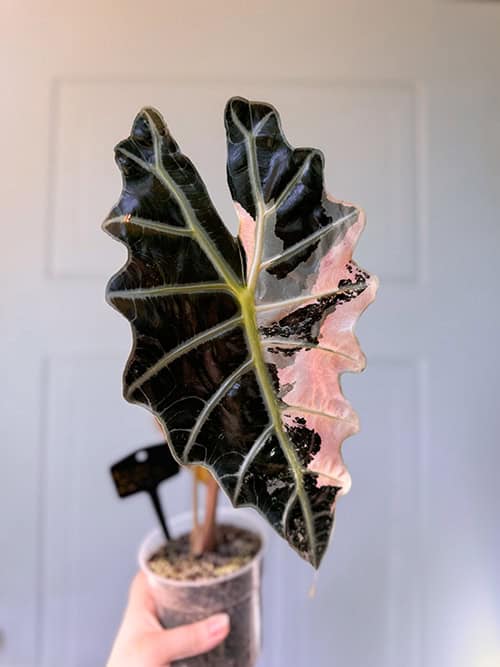
Alocasia amazonica Albo Pink Variegata
Alocasia Amazonica Albo Pink Variegata is a variant of Alocasia amazonica featuring white and pink variegation. The green parts of the plant are deeply dark and, in some lights, almost black.
Occasionally, you might come across a plant named Alocasia 'Polly' with similar variegation. Sometimes these plants are discussed as synonyms, but 'Polly' is actually a dwarf version of Amazonica, making it smaller and more compact.
Like other Alocasias, this plant requires bright indirect light and high humidity. Due to its variegation, proper lighting is especially important because the pink parts cannot photosynthesize.
So far, this variegated Amazonica is the most expensive plant I have ever purchased (Edit: Aug 2024 …naaaah, not anymore). The high price was due to its high-quality variegation, the plant’s age, and its robust size. Variegated Amazonicas are more commonly found in smaller sizes, and the dwarf version, ‘Polly’, is becoming increasingly popular. However, a large, mature, well-gened Amazonica is certainly not a given.
The plant had two leaves when it arrived. I received pictures just before it was packed. The packaging was very meticulous. I remember noticing a very slight yellowing on the edge of one of the leaves. But it didn’t seem dangerous. When the yellowing spread rapidly within 24 hours, I contacted the grower. I received excellent support, and together with the grower, we examined the possible causes. Under normal circumstances, yellowing leaves could indicate overwatering, fungal disease, or pests. We checked the plant’s roots, and fortunately, they were in perfect condition. The newer, larger leaf was also in excellent condition. Additionally, we observed that the plant was preparing to produce a new leaf. So, ostensibly, nothing else was wrong.
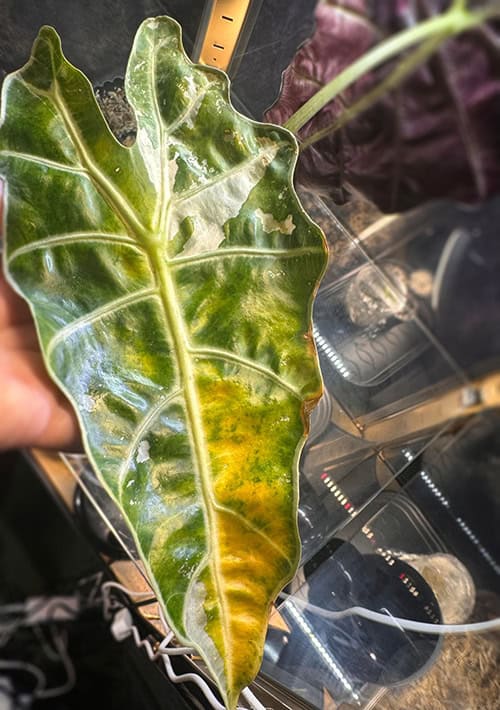
So far, this variegated Amazonica is the most expensive plant I have ever purchased. The high price was due to its high-quality variegation, the plant’s age, and its robust size. Variegated Amazonicas are more commonly found in smaller sizes, and the dwarf version, ‘Polly’, is becoming increasingly popular. However, a large, mature, well-gened Amazonica is certainly not a given.
The plant had two leaves when it arrived. I received pictures just before it was packed. The packaging was very meticulous. I remember noticing a very slight yellowing on the edge of one of the leaves. But it didn’t seem dangerous. However, the yellowing spread quickly and progressed to completion within a couple of days.
It’s typical for an Alocasia to drop an old leaf in favor of a new one to ensure the new leaf gets all the energy. Thus, understanding the plant’s typical nature, it was clear that the yellowing leaf would fall relatively soon. The stress of transport and lack of moisture and light signaled to the plant, “Hey, there’s a big energy shortage. Better drop something so the new leaf gets enough energy.” This is exactly what happened.
Of course, there’s a slight complication that stress can sometimes halt growth. In the case of this Amazonica, the new leaf paused its growth, waiting for more stable conditions—but the tip remains green and active. My Alocasia tandurusa (‘Jacklyn’) also did this. One leaf yellowed, and the growth of the new leaf stopped. Now, about a month later, the new leaf’s growth has reactivated, and the plant has generally become more vibrant.
My Amazonica is currently doing well. Its roots have grown a bit, which is promising! Time will tell.
On the left, the roots of my Amazonica variegata when the leaf started to yellow; on the right, about a month later. There no new leaf yet, but the rooth growth is quite impressive.
CASE 2: Alocasia "Bambino" Pink Variegata
- Watering mistake and stress caused half of the leaves to drop
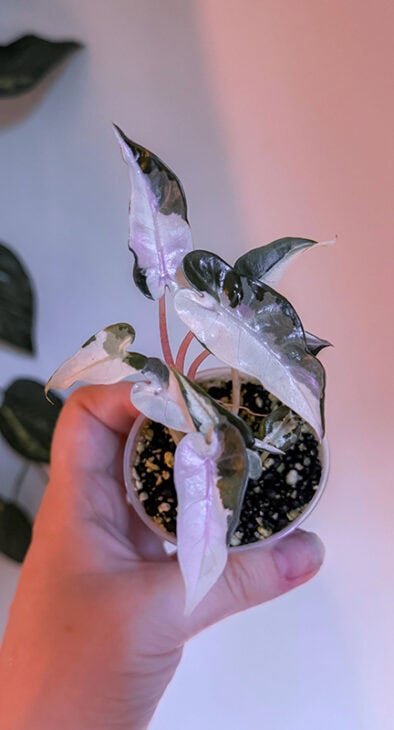
Alocasia 'Bambino' Pink Variegata
Alocasia x amazonica 'Bambino' is a compact hybrid Alocasia, featuring long, narrow leaves with beautifully contrasting veins. It typically remains fairly small, around 30-40 cm in height, although it tends to produce more leaves compared to some other Alocasia varieties. The variegated, or "color-mistaken," pink Bambino is a strikingly charming and beautiful plant, with its pastel, translucent variegation exuding an ethereal beauty.
Pink Bambino plants are now relatively easy to find among enthusiasts, although they rarely make their way into regular flower shops. The growing popularity has made them more accessible, and occasionally, this plant can be found at a reasonable price (especially compared to a few years ago).
With this plant, I completely messed up myself, but I believe stress also played a significant role. My pink variegated Bambino has been extremely sensitive! When I first took it out of the box, there were many translucent spots on the leaves, known as edema. In plants, edema occurs when the plant absorbs more water than it can transpire, causing the cell structures to break down. Imagine the cells “popping” from the excess water.
The signs disappeared within a day, and I thought everything was fine. A couple of small leaves dropped, but I chalked that up to stress. But then started a strange zigzag pattern, where it felt like nothing was quite right for the Bambino pink. Sometimes it wilted. Then I moved it closer to the light, and it perked up… but then a leaf curled a bit. I moved it farther away. Then everything was fine for a while.
But then I messed up out of sheer carelessness in my morning haze: I was watering and fertilizing the plants at the same time. I noticed that the Bambino’s perlite + Fluval Stratum mix was a bit dry, and one leaf tip was dry. “I’ll just pour a little…” Well. My experience has mostly been with perlite, soil, moss, coconut coir, peat, and orchid bark – but Fluval Stratum was new to me.
Fluval Stratum is a nutrient-rich growing medium designed specifically for aquarium plants. It is made from mineral-rich volcanic soil and usually comes in small black granules. Some people even call it unicorn poop. 🙂 Fluval Stratum helps promote healthy root growth and strengthen the vitality of plants. Since it is already nutrient-rich, it doesn’t need to be fertilized.
Moreover, a new plant should not be fertilized during the first few weeks! And the perlite-Fluval mix doesn’t need much watering if it is kept just moist.
And what did I do? 1) Poured water with fertilizer in it 2) My hand shook just enough that quite a bit ended up in the tiny seedling cup, which is only slightly larger than a shot glass.
“Oh f— f— f—…”
Well, I decided to see what would happen. It didn’t even take a day for the plant to become full of edema, with the leaves looking like glass.
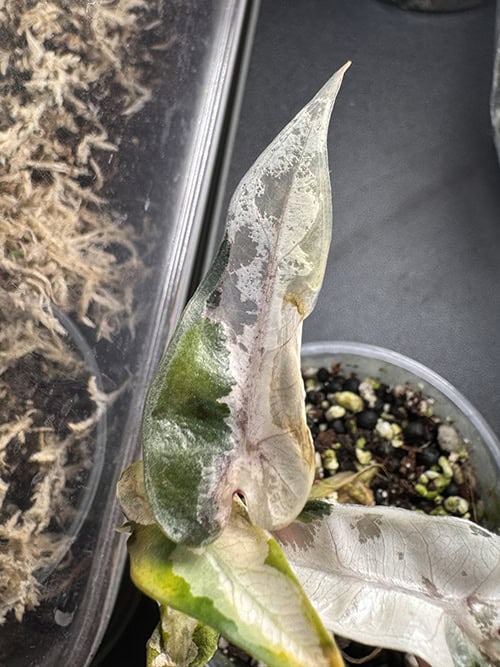
Luckily, the signs appeared on the oldest leaves, and almost comically, the damage progressed in order from the oldest to the newest leaf. The roots still looked good, and I didn’t want to stress the plant further by removing it. Edema can heal from the leaves quite quickly. However, when about 30% of the plant was affected, and edema had spread to all the leaves, I decided to take action. It was just in time because, although some roots were beautifully white, root rot had also begun to develop.
I removed all mushy areas, damaged roots, and leaves. I changed the entire growing medium and dipped the remaining root ball in a solution of 1 part bleach to 10 parts water. I lightly coated some of the roots with rooting hormone gel (partly because I wasn’t sure at this point what the plant could tolerate) and placed it very gently in a mix of slightly moistened perlite, Fluval Stratum, and moss pieces.
While the Bambino lost many leaves, in the end I won the battle and saved the plant. Here the fault was completely my own. I stressed the plant even more when it was already stressed. Luckily I won the battle.
CASE 3: Alocasia Black Velvet Albo Pink Variegata
- Tissue Cultured Baby Plant Changed Its Color
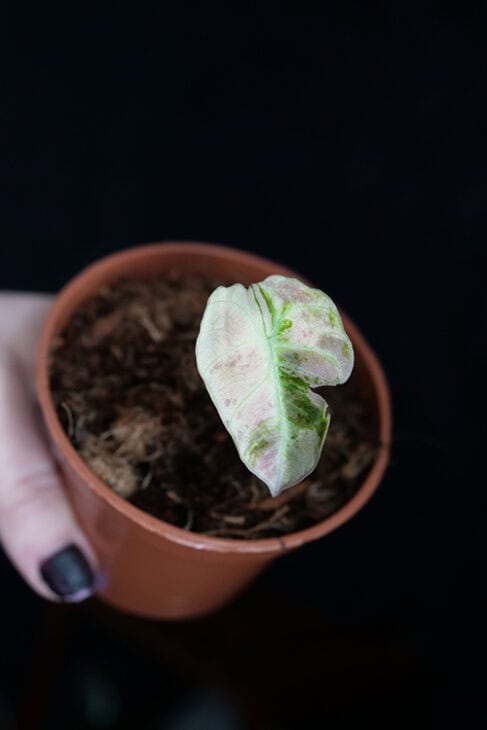
Alocasia Black Velvet Albo Pink Variegata
Black Velvet is a popular Alocasia known for its very dark, velvety leaves. When variegation is added, it becomes Alocasia Black Velvet Variegata, and the variegation can be white (albo), pink, or yellow-green (aurea). The variegated Black Velvet is truly striking and beautiful. Especially the "full moon" leaf with pink variegation looks particularly charming and is a favorite among Instagram content creators. And no wonder: a full moon leaf on this plant looks like candy-colored velvet. However, Black Velvet Variegata is a demanding plant that grows relatively slowly. A mature plant can cost several hundred euros.
This is perhaps the strangest of cases. It involved my first “tissue culture” plant. In tissue culture, a plant is cloned into multiple small plants in a laboratory using various chemicals and hormones. The advantages of tissue culture are that even rare plants can be produced more easily, and since the plant comes from a sterile environment, it is guaranteed to be disease-free and pest-free. The downside, however, is the instability of the plants. Especially when young, they are very sensitive to stress. When a tissue-cultured plant is still in its lab pouch, it’s like a baby in the womb. When the pouch opens, the plant takes its first breath and has to learn to photosynthesize independently. This is a significant strain in itself.
Additionally, the process can either create or lose mutations, making the plants’ characteristics much more unstable. For example, a variegated plant may revert more easily, or its coloration may behave unpredictably.
My tissue-cultured Alocasia Black Velvet Albo Pink Variegata went through two post-transport stress symptoms. One was more typical, and the other less so. First, it curled the edges of its leaves upward, trying to adjust to its new environment. This was still easy to understand.
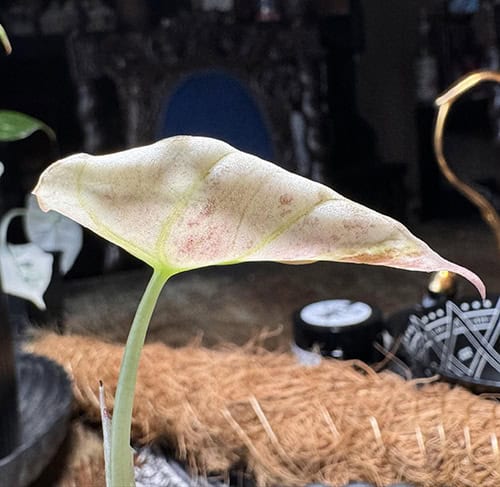
But then a significant heatwave hit Espoo, with temperatures jumping from 22 degrees Celsius to around 30 degrees and fluctuating for about a week. The Black Velvet Albo Pink reacted quite dramatically and started producing chlorophyll in the pink areas. This was particularly unfortunate because, well… if you buy a “PINK” variegated plant, you’d like it to stay pink!
It also wilted and looked a bit pitiful at times, earning the nickname “Rääpäle” (runt). Interestingly, the variegation didn’t close up but rather started to resemble aurea more than albo/pink. I kept a close eye out for pests, but there were no signs of any. Eventually, it suddenly pushed out a new leaf at a furious pace. This new leaf was also strange, appearing to display both pink and green at the same time. Initially, the color looked mixed, but over the next few days, variations began to appear. For example, the pink started to intensify near the base, while darker areas began to emerge further along, suggesting variegation.
I don’t yet know enough about tissue-cultured Black Velvet Pinks to say definitively what caused all this. However, based on everything I’ve read, studied, and learned, it seems that these color fluctuations are typical of a stressed, tissue-cultured Alocasia Black Velvet Pink Variegata.
Time will tell how the color of this “runt” develops. The main thing is that it is healthy! I am eagerly waiting to see what happens next.
Above: the color change from pink to green, and the new leaf showing both green and reddish hues simultaneously.
Alocasias are complex houseplants, and their sensitivity doesn’t exactly help when you want to transport a new plant home by mail. However, don’t give up and don’t beat yourself up. In most cases, no-one has probably done anything wrong; this is just how Alocasias behave. And even if you have given a bit too much love for your plant, that’s more common than you’d think.
If you want to minimize your plant’s stress as much as possible, provide optimal conditions and avoid any changes. And no matter how much you want to treat the plant with fertlizer and extra watering, sometimes less is more.


